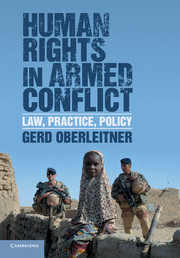Book contents
- Frontmatter
- Contents
- Acknowledgments
- Table of cases
- Table of Legal Instruments
- List of Abbreviations
- Introduction
- Part I Human rights in armed conflict: history of an idea
- 1 From medieval sources to modernity
- 2 The science of warfare and the progress of civilization
- 3 1945: whither war?
- 4 Human rights in armed conflict
- Part II Human rights and humanitarian law: theory
- Part III Human rights and humanitarian law: challenges and commonalities
- Part IV The dynamics of war and law
- Part V Enforcement: practice and potential
- Conclusion
- Bibliography
- Index
- References
3 - 1945: whither war?
Published online by Cambridge University Press: 05 March 2015
- Frontmatter
- Contents
- Acknowledgments
- Table of cases
- Table of Legal Instruments
- List of Abbreviations
- Introduction
- Part I Human rights in armed conflict: history of an idea
- 1 From medieval sources to modernity
- 2 The science of warfare and the progress of civilization
- 3 1945: whither war?
- 4 Human rights in armed conflict
- Part II Human rights and humanitarian law: theory
- Part III Human rights and humanitarian law: challenges and commonalities
- Part IV The dynamics of war and law
- Part V Enforcement: practice and potential
- Conclusion
- Bibliography
- Index
- References
Summary
1914–1945: war as trauma and war as crime
In this blend of legal positivism, civilizing spirit, military necessity and charitable impetus the law of war was codified at the turn of the nineteenth to the twentieth century. The hope that this evolving legal framework with the more than twenty general and specific conventions and declarations in place back then would make a difference in the protection of those affected by war was high: “[t]he nineteenth century formulated the laws of war; the twentieth century was expected to apply them.” Such expectations were shattered in the First (1914–1918) and Second World Wars (1939–1945). As all wars, they had to be fought in the framework of the existing law of armed conflict but twentieth century wars proved to be an altogether different matter. For the world as much as for the established law of war, the two wars were traumatic experiences, which would eventually lead to a rebranding of the law as international humanitarian law and would see the birth of international human rights law.
The First World War saw established laws and customs of war violated widely. New means of warfare ridiculed the treaties and declarations so pompously celebrated only a few years ago, and the technocratic rules of the law of war could easily be circumvented. The first use of poison gas by the Germans in 1915, for example, was justified with reference to the 1899 Declaration on Asphyxiating Gases which prohibited the use of such gases when diffused by projectiles while in fact it was released from thousands of cylinders stationed along six kilometres of frontline. On the other hand, even respecting the laws of war meant unspeakable horror: the hundreds of thousands of soldiers slain by new technology such as machine-guns and far-ranging artillery were not necessarily killed in violation of the laws of war which (to paraphrase the words of the 1868 Declaration of St. Petersburg) saw as the legitimate object of warfare the weakening of enemy armed forces without superfluous injuries.
- Type
- Chapter
- Information
- Human Rights in Armed ConflictLaw, Practice, Policy, pp. 38 - 51Publisher: Cambridge University PressPrint publication year: 2015

